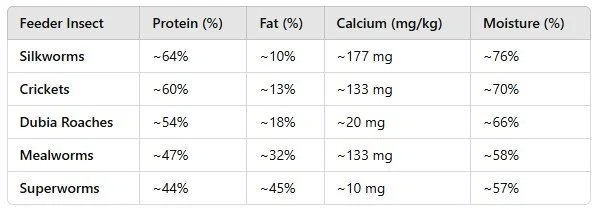Silkworms as Feeder Insects: Care, Nutrition & Feeding Recommendations
Silkworms (Bombyx mori) are one of the best feeder insects for reptiles, amphibians, and even some fish. They are nutrient-dense, soft-bodied, and easy to digest, making them an excellent choice for pets that require a high-calcium, low-fat diet.
However, silkworms require special care to thrive. They are delicate insects that can easily perish due to improper husbandry or disease. Additionally, their fascinating history and transformation into moths make them one of the most unique feeder insects available.
In this guide, we'll cover how to care for silkworms, their nutritional benefits, a comparison to other feeder insects, their history, and how to use them effectively as feeders.
The Nutritional Value of Silkworms
Silkworms are one of the most nutritious feeder insects available. Compared to crickets, mealworms, and Dubia roaches, they provide an excellent balance of protein, calcium, and hydration, making them a superior choice for many reptiles.
Silkworm Nutrition Profile (Per 100g Dry Weight)
Protein: ~64%
Fat: ~10% (low compared to superworms or mealworms)
Calcium: ~177 mg/kg (higher than most feeder insects)
Moisture Content: ~76% (great for hydration)
Silkworms vs. Other Feeder Insects (Nutritional Comparison)
Why Silkworms Are a Superior Feeder Insect
✔ Higher Calcium Content – Silkworms provide significantly more calcium than Dubia roaches or superworms, helping to prevent Metabolic Bone Disease (MBD) in reptiles.
✔ High Protein & Low Fat – Unlike mealworms and superworms, silkworms contain more protein and much less fat, making them an ideal staple feeder.
✔ Better Hydration – With 76% moisture, silkworms provide extra hydration, especially useful for reptiles that don’t drink much water.
✔ Easier to Digest – Unlike mealworms or superworms, silkworms lack a hard chitin exoskeleton, making them easier on the digestive system.
Why Choose Silkworms as Feeders?
Silkworms are a superior feeder option compared to traditional insects like crickets, mealworms, and Dubia roaches. Here’s why:
1. Soft-Bodied & Easy to Digest
Because silkworms lack a hard exoskeleton, they are easier to digest than other feeder insects. This makes them perfect for baby reptiles, sick or injured animals, and species prone to digestion issues.
2. Slow-Moving & Easy to Catch
Unlike crickets, which can jump away, silkworms are slow-moving, making them easy for reptiles to hunt. This is particularly helpful for species that struggle with catching fast-moving prey.
3. Low Fat & High Hydration
Silkworms contain a higher water content than many feeder insects, helping keep reptiles hydrated while maintaining a low-fat diet.
The History of Silkworms: More Than Just Feeders
Silkworms have been domesticated for over 5,000 years, primarily for silk production. Originating in China, they were first cultivated for their ability to spin strong, luxurious silk cocoons. Ancient Chinese royalty prized silk, and for centuries, the Silk Road served as a vital trade route connecting China to the rest of the world.
Silk production (sericulture) remains a major industry today, but silkworms have also become highly valued as feeder insects due to their nutritional benefits, soft bodies, and easy digestibility.
Despite centuries of breeding, modern silkworms no longer exist in the wild. They are now fully domesticated and completely dependent on humans for survival.
Silkworm Growth & Life Cycle
Silkworms grow rapidly, with their size and lifespan depending on temperature and diet.
Silkworm Growth Stages:
✔ Egg Stage – Eggs hatch in 7-14 days under ideal conditions.
✔ Larvae Stage (Silkworm) – This is the stage sold as feeders. Silkworms grow for 25-30 days, increasing in size daily.
✔ Cocoon Stage (Pupal Phase) – After about a month, silkworms spin silk cocoons and remain inside for 10-14 days.
✔ Adult Moth Stage – The moth emerges from the cocoon but cannot fly due to thousands of years of domestication. Silkworm moths live for 5-10 days, mating and laying eggs before dying.
Caring for Silkworms: Keeping Them Alive Longer
Silkworms require specific care to keep them alive and healthy before feeding. They are delicate and can die if exposed to harsh conditions, mold, bacteria, or insufficient food.
Preventing Disease & Death
Silkworms are extremely fragile and susceptible to bacterial infections, mold, and dehydration.
❌ Do NOT touch them with wet or dirty hands.
❌ Do NOT overcrowd them, as poor ventilation can lead to disease.
❌ Do NOT feed them anything other than mulberry leaves or silkworm chow.
Where to Buy Live Silkworms
At PNW Reptile Bites we offer high-quality live silkworms in various sizes to meet your reptile’s needs. Each order includes a small amount of silkworm chow, but we recommend purchasing extra chow to extend their lifespan.
📌 Order now! We offer flat-rate shipping and local pickup options for your convenience.
🌍 Shop Now: www.PNWReptileBites.com
Final Thoughts
Silkworms are one of the best feeder insects available due to their high nutritional value, digestibility, and ease of feeding. However, they are also delicate and require proper care to prevent premature death. By understanding their growth cycle, feeding needs, and care requirements, you can ensure your reptile gets maximum health benefits from this premium feeder insect.
Have questions? Let us know in the comments or reach out—we’re happy to help!
🐛🦎 Happy Feeding!

